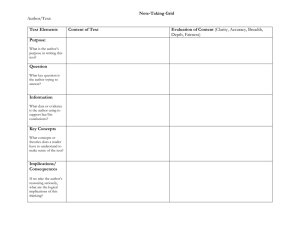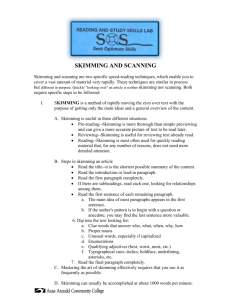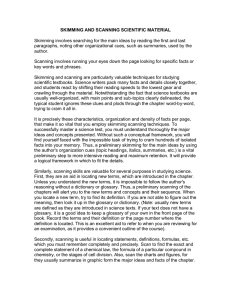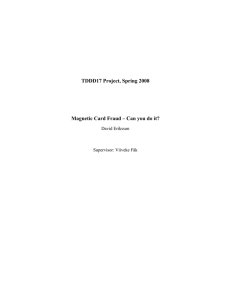Document 11283406
advertisement
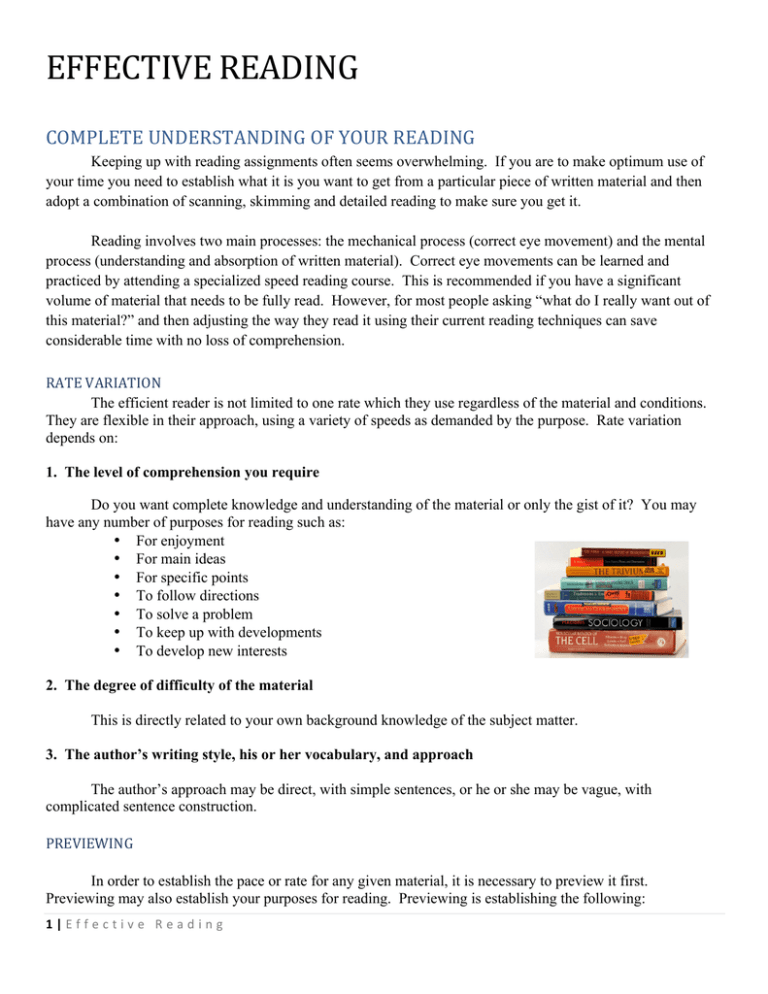
EFFECTIVE READING COMPLETE UNDERSTANDING OF YOUR READING Keeping up with reading assignments often seems overwhelming. If you are to make optimum use of your time you need to establish what it is you want to get from a particular piece of written material and then adopt a combination of scanning, skimming and detailed reading to make sure you get it. Reading involves two main processes: the mechanical process (correct eye movement) and the mental process (understanding and absorption of written material). Correct eye movements can be learned and practiced by attending a specialized speed reading course. This is recommended if you have a significant volume of material that needs to be fully read. However, for most people asking “what do I really want out of this material?” and then adjusting the way they read it using their current reading techniques can save considerable time with no loss of comprehension. RATE VARIATION The efficient reader is not limited to one rate which they use regardless of the material and conditions. They are flexible in their approach, using a variety of speeds as demanded by the purpose. Rate variation depends on: 1. The level of comprehension you require Do you want complete knowledge and understanding of the material or only the gist of it? You may have any number of purposes for reading such as: • For enjoyment • For main ideas • For specific points • To follow directions • To solve a problem • To keep up with developments • To develop new interests 2. The degree of difficulty of the material This is directly related to your own background knowledge of the subject matter. 3. The author’s writing style, his or her vocabulary, and approach The author’s approach may be direct, with simple sentences, or he or she may be vague, with complicated sentence construction. PREVIEWING In order to establish the pace or rate for any given material, it is necessary to preview it first. Previewing may also establish your purposes for reading. Previewing is establishing the following: 1 | E f f e c t i v e R e a d i n g • • • • • • Publication date Chapter headings, sub-headings and summaries Maps and diagrams Writing styles Degree of difficulty Length SKIMMING Skimming is the technique by which a reader establishes very quickly a rough outline of a text about which they have little knowledge. This technique is a well-defined reading skill. Skimming is a highly selective process of looking at a page so that the reader is able to quickly grasp the information they need. There is no element of chance – the reader covers the material quickly with the least margin of error and collects the information they require. Apart from obvious information, such as headings, sub-headings and words in italics, the idea is to focus on the key words or main ideas. The quickest and most efficient method of skimming is a highly selective process of looking at a page so that the reader is able to quickly grasp the information they need. There is no element of chance – the reader covers the material quickly with the least margin of error and collects the information they require. SCANNING Scanning is not the same as skimming, and it may not be necessary. Skimming consists of quickly covering all the material and taking note of the main points. In scanning, you ignore the bulk of the material and look only for specific information. In order to scan efficiently, you must be quite clear, from the beginning, of what you are looking for. You look quickly over the page not even attempting to comprehend it, but when your eye catches a piece of information you want, your mind is alert to seize it. NOTE-­‐TAKING Note-taking when used properly is one of the most efficient ways of recalling things. The rules for note-taking are: • Read the entire article first. This establishes perspectives and a general understanding. • Go back and make notes of major points. • Notes should be based on understanding, not as an aid to understanding. • Notes should be concise, clear and with as little detail as possible – merely subheadings. Notes that are assembled in some kind of pattern, based on proper understanding, and reviewed correctly will be most effective in helping you learn and retain the subject matter. Pattern Notes are designed to get ideas from your head onto paper. Thoughts do not come into our minds in a logical order or in a series of straight lines. Rather they come in a random, unstructured and, at times, illogical order. 2 | E f f e c t i v e R e a d i n g In order to work as our brain works, write the subject of the report or speech in the center of a large page and then note down in a purely random manner the key words that relate to that subject. Link these key words to the subject in the center of the page. One idea will trigger another. The idea at this stage is not to give any order or classification, but simply to empty your mind of ideas and get these onto paper. You will be amazed how many ideas this method of note-taking produces in this spontaneous and creative way. Having created this unstructured pattern, the next step is to edit the pattern. Link the points that are relevant to the introduction, the conclusion and the various themes of the topic. During the editing phase additional points may occur to you and can be added. Also irrelevant points can be deleted. It is worth noting irrelevant points in the first place because these could trigger other ideas that are relevant. Rewriting a pattern note into a structured pattern note where there is a logical order to the material will help you to remember key points. This form of note-taking uses the brain’s ability to remember patterns as well as written material. AN EFFECTIVE EVALUATION APPROACH Any written material can be studied in the following way: • • • Preview the article. Establish its length and layout. Skim the article for the main ideas. Read the article from start to finish, not stopping, even though you may be tempted to dwell on some of the facts. If necessary, make small marks in the margins on points fully understood. Once completed, you will have a general understanding of the article, and perspectives will have been established. • Scan to find the facts or information requiring attention. The important information should be that which is new to you. Make pattern notes of the relevant facts or ideas. Depending upon the need, memorize the facts, quotations, and dates. • • 3 | E f f e c t i v e R e a d i n g


